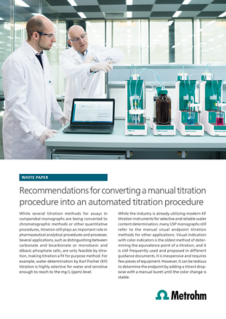What is an automatic titrator?
An automatic titrator, or autotitrator, performs the titration procedure automatically, including endpoint and equivalence point detection, results calculation, sample preparation, and sample series analysis. The steps performed by an automatic titration system from Metrohm are:
- The titrant is added with an automated piston buret. This ensures that the volume of titrant added is precise.
- A stirrer mixes the sample solution during the titration. This ensures reproducible results.
- The electrode detects the endpoint. This removes subjectivity of color changes present in manual titrations.
- The results are automatically calculated and displayed. This limits the risk of human errors.
With sample robots such as the OMNIS Sample Robot from Metrohm, you can take automation one step further. The OMNIS Sample Robot allows you to analyze up to 175 samples in one run, completely unattended.
Learn more about autotitration and the advantages over manual titration in our blog:
Blog: Why consider automation – even for simple titrations
Blog: How to avoid titration errors in your lab








